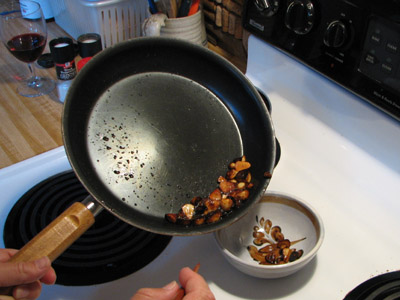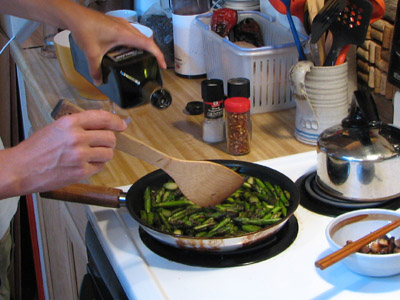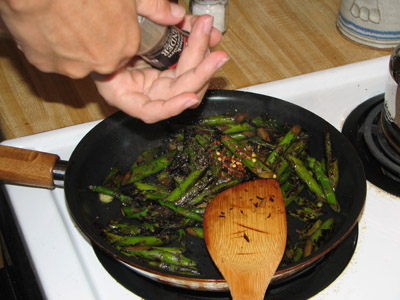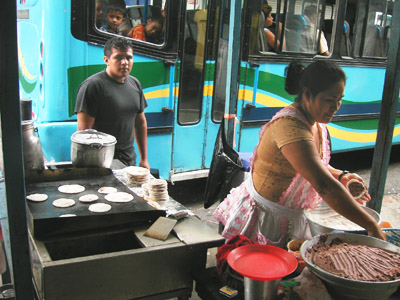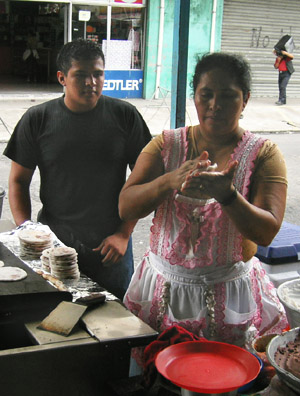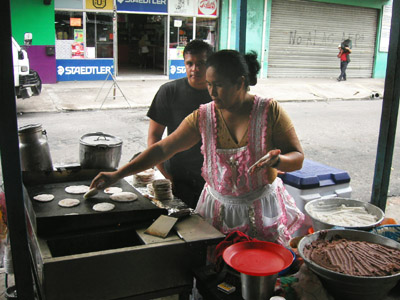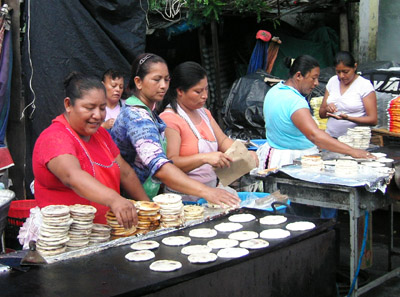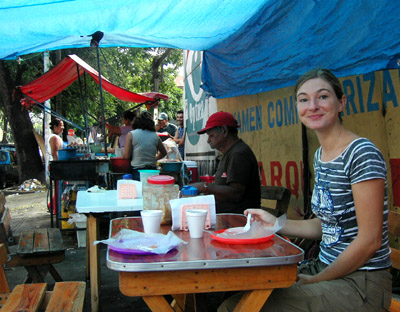Knives on a Boat
Monday, July 9th, 2007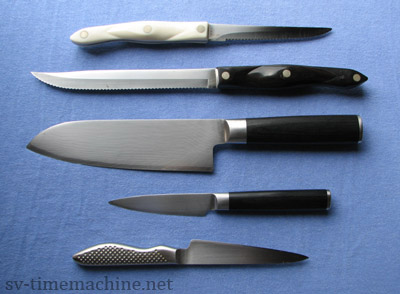
[Top to bottom: Cutco “Trimmer” (Small), Cutco “Petit Carver” (Meduim), Shun Santoku, Shun Paring, Global Pro Paring. Sorry, but I don’t have any photos of the fish knives.]
In preparation for Boat Life, I wanted durable, dependable, reliable knives. Knives that would be able to hold their edge yet be easy to sharpen when necessary. Not too large, not unwieldy, comfortable to grasp, easy to clean. I needed knives that could cook a hot meal underway in shite weather without even being told what to make. Knives that would serve me coffee with just the right amount of sweetened condensed milk syrup in my bunk. A tall order, really, when you think about it. Here’s what I came up with:
SHUN SANTOKU (6.5-inch)
This knife is beautiful; quite possibly the most beautiful knife I’ve ever seen that you can just run out and buy from, like, Amazon. It is the perfect length for a boat because there’s not a lot of space to get fancy in the galley of a 31-foot trimaran. This is a knife I purchased specifically to bring with us because the French chef’s knife I typically used at home was about seven feet long. I had never used a santoku style knife before but I thought they were cool, and I am always enthusiastic about experimentation with sharp objects. Hours and days of exhaustive research on the subject of santokus and Japanese knives later, I chose this one.
SHUN PARING
Amazon.com had a super deal on the paring knife if you bought the santoku. It didn’t take a lot of convincing in my case.
GLOBAL PRO PARING
There’s a story behind how we obtained this knife. We were in Tokyo (it was 2002) in the section of town where you can buy all that insane cookware and plastic sushi, and we wandered into a knife shop after seeing a display of Global knives. Now, we had had our eye on the Global Sashimi knife for probably two years but they are bloody expensive in the US and so we looked (much) but did not touch. In fact, we looked whenever we might, which is why we found ourselves sucked into this Tokyo knife shop even though we didn’t expect to be able to afford anything there either.
But! Fate!! A group of Danes entered and we all greeted one another enthusiastically after recognizing each other from the ferry earlier. We wandered around this tiny shop, which seemed to be more of a wholesale type place, not a standard retail. They were called Yoshikin and carried only Global knives, and they had every possible one made. Stacks of them. We got to chatting with the Danes; it turns out they were all Ericson employees and had a special arrangement with this company. They were there to buy knives at a corporate discount of 40% and they said we should pretend we were with them to get the same deal. The shop guy already assumed we were Danish Ericson Folk anyway and so we decided that this would probably work out for us.
We pored over the options (many) and selected the much-lusted-after sashimi knife and a paring knife, for the hell of it. (I didn’t have a paring knife at all at the time.) The shop had both Global regular and Global Pro knives and the shop guy politely and emphatically explained that the Global Pro were professional grade knives with better steel and a more elaborate crafting process, not that mass marketed stuff you can find in any high-end knife shop in Denmark (cough, or the US). They were more expensive (although not extremely so) but we figured that if we were going to splurge, we should go all out and get the fancy ones. The only visual difference was that the Global had a black patina in the handle bumps; the Global Pros did not.
We had a fun experience getting this sword-sized knife on the plane back to San Francisco, but that’s another story. This is also why we ended up on the boat with only the paring knife and not the sashimi knife. (Too big.)
SMALL CUTCO
This is a very versatile serrated knife and we’ve had it forever. I will not tell you how we got it. In its defense, it had always gotten used a lot.
MEDIUM CUTCO
For some stupid reason, I decided that we would NEED a bread knife but my regular bread knife is about 16 inches long. Which is to say, longer than the trimaran galley itself and a hazard. I compromised on this knife thinking I could deal with the small loaves of bread and carve a chicken too if the opportunity came up. Well, the first fresh bread of the trip didn’t hit our boat until Isla Guanaja; kind of pathetic but we don’t have an oven and I’m particular. I probably used it all of six times in 18 months.
MAJOR FISH KNIFE
I have dealt with precious little raw meat in my life and fish least of all. Once when I was 13 or something, we went to a lake on a family vacation and I put a pole in the water. Bored after about ten seconds, I abandoned it for a good 24 hours or more. When I finally wandered by again, a small trout was twitching on the other end. I freaked out and called for help. My grandmother, who I had assumed was on my side, came trotting down to the dock, snatched up the fish, yanked the hook from its mouth, produced a knife from her apron and sliced the head clean off in less than a second. She then kneeled down on the dock, cut the fish from gaping, bleeding hole to tail, stuck a finger in, yanked out a bit of stringy blobby guts and slung them out in to the lake where they slowly sunk to the bottom. Then she took the blade and scraped it across the dead body, like petting a cat the wrong way; scales popped and zinged all over her knees. The whole operation took probably 20 seconds. Thusly, I was the appalled bringer of the breakfast bacon. It was pan-fried and served alongside the more standard morning offerings but I think mom was the only one who actually ate it.
So, I knew fishing would be involved on this trip and knives would be needed to cut them up in special ways. The least I could offer was to do my part in shopping for such a knife and I went to a shop with a humongous display of knives and asked the knife person what she recommended. I think she had larger fish in mind. This knife was more useful as a pirate prop than a functional cutting device.
MINOR FISH KNIFE
A smaller six and a half incher is actually the fish knife we used. Jeff bought it for us in Ensenada after I nearly beheaded the binnacle showing off our pirate’s booty. Turns out that we tend to catch fish when we go at least six knots, and usually much faster; this means that the seas and weather conditions are often large and sucky. And, since I am still traumatized by the lake trout, Joshua is officially in charge of turning live thrashing fish into the delicious filet. The smaller knife just worked out better in that there was less leg to cut off if he missed.
THE VERDICT
I used the Shun santoku and the Global Pro paring knife BY FAR the most. It is not an exaggeration to say the santoku was out every time any meal was prepared on the boat (twice per day for eighteen months). The major fish knife was almost never used, nor was the larger Cutco. The Shun paring was in third place and the small Cutco was a ways behind it. I think basically, only one paring knife was really necessary (an eighteen-inch galley is strictly a one-butt affair). Particularly interesting is the way the blades have held up to boat abuse. I did my best to take care of them but conditions on a boat are not always the most delicate. I wasn’t going to NOT use them for fear of damaging them.
The Global Pro steel held up excellently—far better than the Shun. Even the comparison between the two paring knives (the Global being more frequently used) shows that the Shun paring steel has a lot more wear. The Global pro knife shows almost no nicks but both the Shun knives have nicks running the entire length of the blade. I hate dull knives and so I have Joshua sharpen the knives whenever they won’t easily dice a tomato; we have very good stones (and sharpener) so I’m disinclined to say that the problem is due only to inexperienced sharpening. I probably don’t need to mention that I always use a cutting board—I favor a mesquite board—and the knives were stowed in a teak wall knife rack.
Behold the horror:
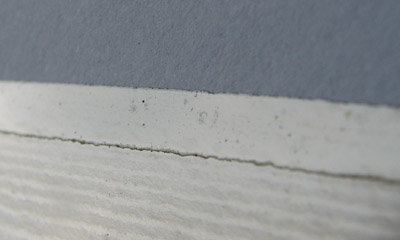
[This is a scary close up of the Shun Santoku. It is horribly pitted pretty much the entire length of the blade. I really hope I can send this to a professional and have the nicks ground out again because I dearly love this knife.]
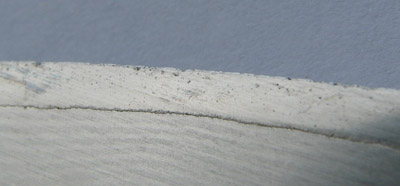
[The Shun paring knife. Man, these close ups make them look terrible!]
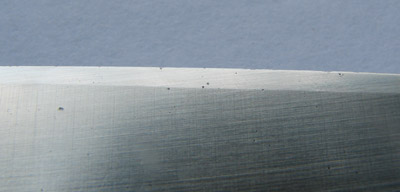
[The Global Pro paring knife, virtually free of nicks and looking great after the ordeal. This is the same scale of close-up as the above Shun photos, by the way. With some diligent sharpening, we can probably grind the few nicks out ourselves.]

